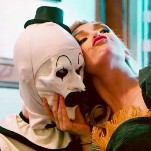Revenge Director Coralie Fargeat on Playing With Film Clichés and the Artistic Power of Blood
Entertainment“Women always have to put up a fucking fight,” Revenge’s main villain, a chiseled, wealthy businessman, at one point spits at the movie’s heroine Jen while the two are locked in a violent duel. French director Coralie Fargeat’s new movie, released May 11, is the story of one blood-drenched, bullet-drilled, goretastic “fucking fight.” A classic rape-revenge movie in structure, but not so much in its gaze, Revenge plays like a highly saturated, delightfully violent parable for men who see pretty girls in tennis skirts and interpret their sexuality as a reason to violate them without consequence.
The movie’s story is simple, with Fargeat drawing her characters like caricatures, and centers on the Barbie-perfect aspiring actress Jen. While settled away in the middle of the desert for a weekend getaway with her rich boyfriend Richard, his two bumbling best friends Stan and Dimitri show up accidentally a day early, ready for what they thought was a hunting trip. After a night of dancing and drinking, during which Jen dances flirtatiously for her three-person audience, Stan mistakes her actions and attitude for an invitation to rape her.
But rather than show the rape scene explicitly, as so many rape-revenge films do, Fargeat turns her camera to silent bystander Dimitri, who turns away from Stan’s crime to eat candy and swim in the pool. When Jen refuses to stay silent about her assault, the men leave her for dead impaled on a tree, from which she rises with superhuman strength. From there, Jen becomes Bloodlust Barbie, transforming into a shooting, knifing, raging machine, rolling through the desert on a motorcycle.
While Revenge might be minimalist on paper, its execution is anything but—it’s loaded with humorous symbolism (it’s not hard to see what Fargeat is saying when Jen rips out a particularly phallic tree branch from her side or a naked Richard has to slip n’ slide his way down a dark, bloody…let’s say, yonic hallway), and an excess of trippy, technicolor gore that calls to mind directors like Dario Argento and David Cronenberg. Watching Revenge, Fargeat’s first feature-length film, it’s easy to be excited about what she’ll do in the future and all the other twisted ideas she must have up her sleeve.
From Paris, she spoke with Jezebel about the genesis of her movie, shooting rape scenes, and what she loves so much about cinematic violence.
JEZEBEL: When did the idea for this story first come to you?
CORALIE FARGEAT: It basically came from the idea of the character, this pretty girl who would be seen at the beginning as being kind of weak and empty because she presents herself in a certain way, crushed by the male gaze, and would be reborn as a very strong and powerful kind of warrior. So it really came from this iconic twist of the Lolita becoming a total self-empowered girl. And I didn’t want to make a very realistic horror film. I was much more inspired by revenge movies like Kill Bill or Mad Max or Rambo—characters who create a whole universe by themselves.
The film plays like such a classic rape-revenge movie, but you’ve said before that you weren’t interested in the specific genre of rape-revenge.
-

-

-

-

-

-

-

-

-

-

-

-

-

-

-

-

-

-

-

-

-

-

-

-

-

-

-

-

-

-

-

-

-

-

-

-

-

-

-

-








































